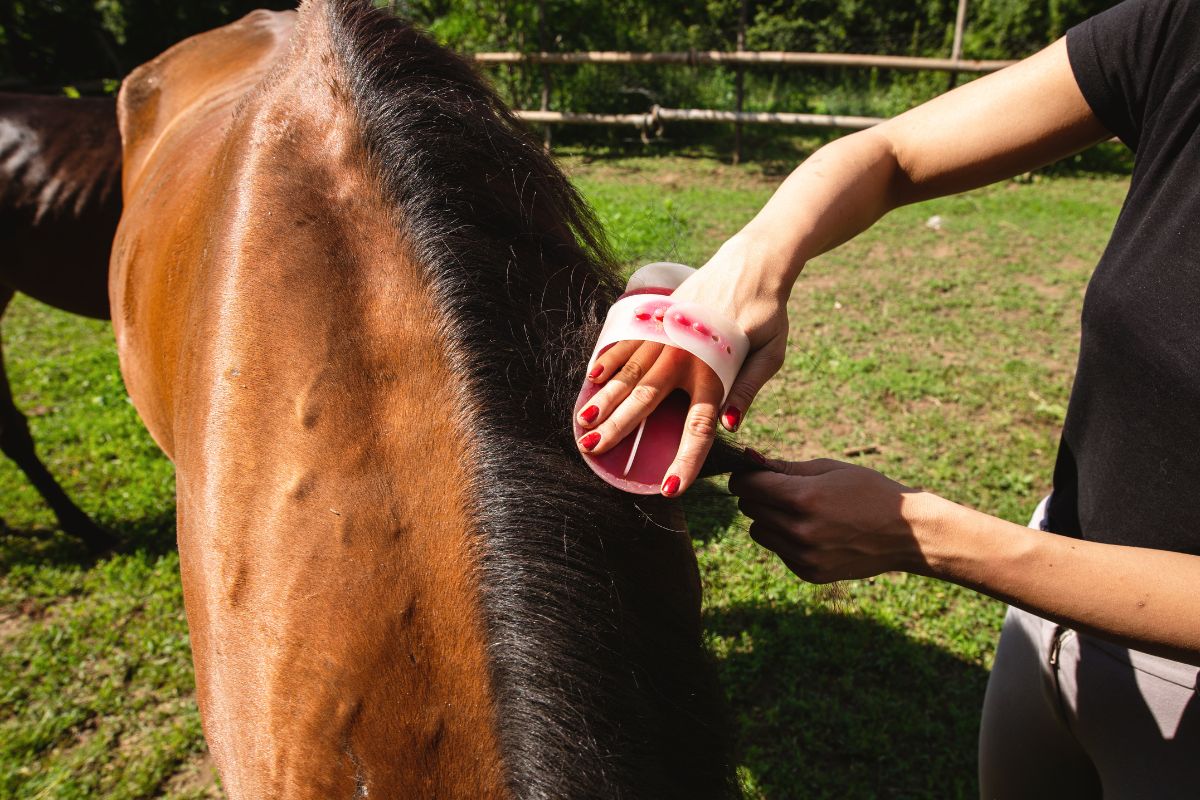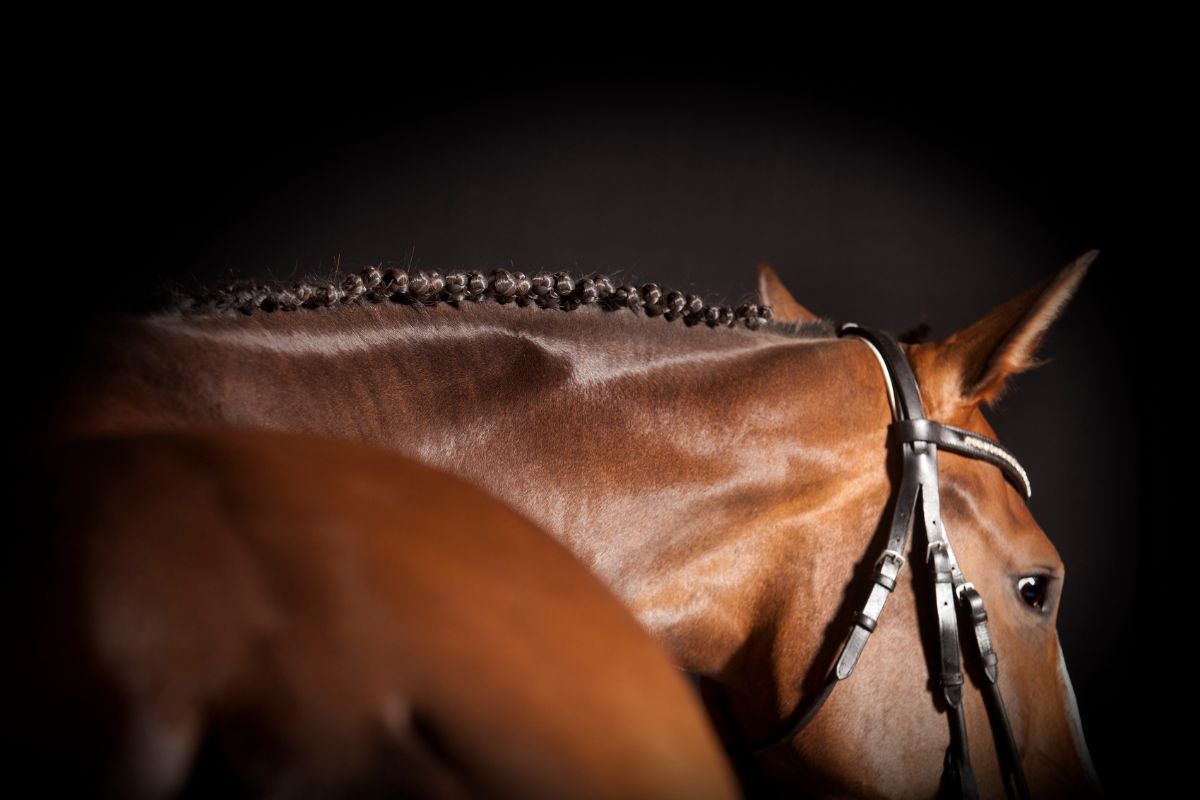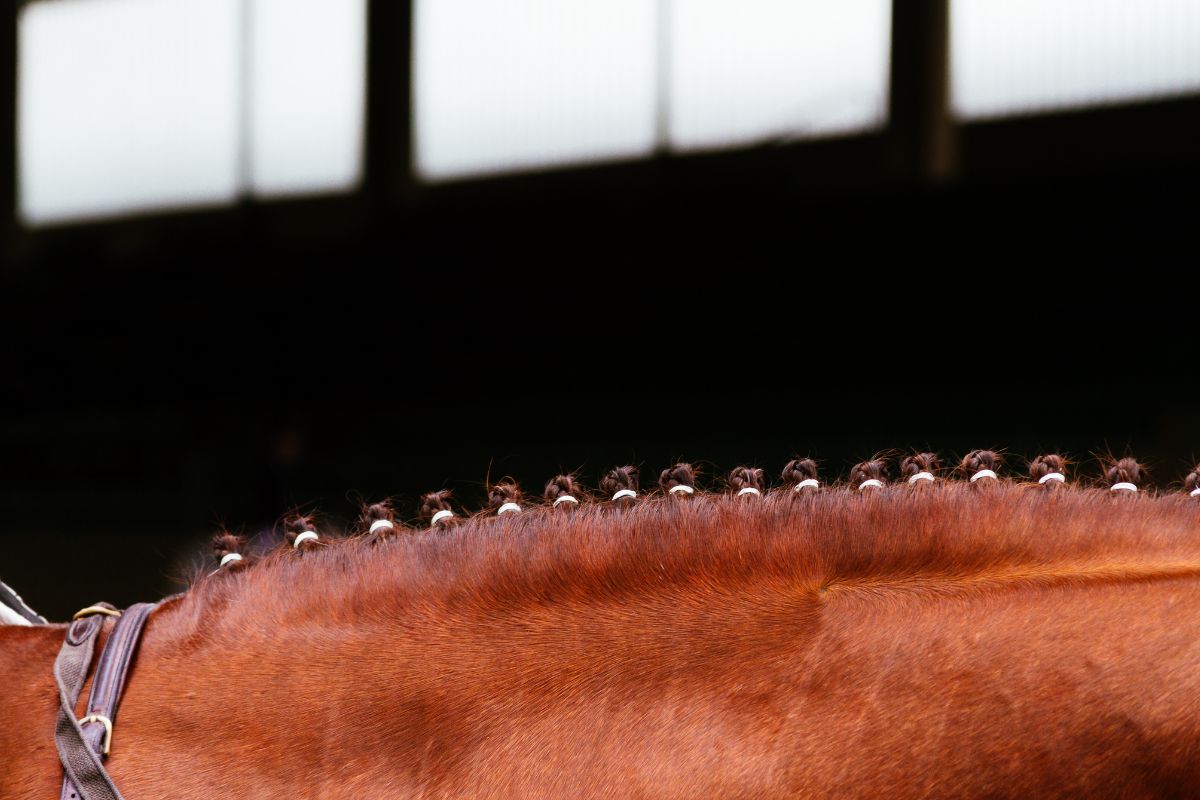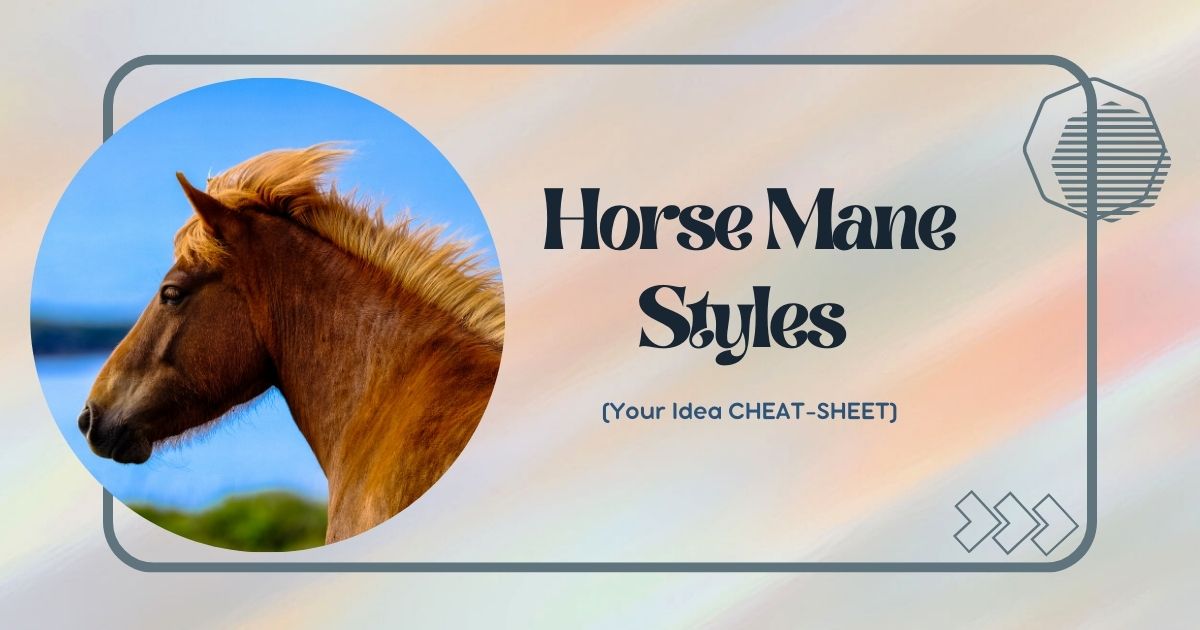Well-Groomed Horse Manes
Let us learn about horse mane styles. The term “mane” refers to the region of a horse’s mane that runs from the top of the neck to the withers. The mane’s thicker, coarser hair than the rest of the horse’s coat keeps the neck warm and may also aid in water discharge.
The mane can aid in fly defense with the tail. A mane can become tangled, twisted, and seriously hurt if left alone.
Why do Horses Have Manes?
Surprisingly, there are several hypotheses about why horses have long manes, and specialists cannot agree on a conclusive explanation. The following are some of the most popular theories.
Protection
A horse’s rear of the neck, where a predator is most likely to latch on (together with the throat), gets protection from the short, erect manes and long flowing manes. Since a predator can’t easily bite through the thick hair, the horse has a better chance of escaping. A horse’s mane may have developed as a defense mechanism against predators.
Warmth
In cold weather, manes can assist keep your horse’s head and neck warm, and in wet weather, they can help keep water off their neck. Horse breeds of colder climate ancestry typically have thick, long manes, perhaps an adaptation to the cold.
Pest Control
Horses use their long tails to swat flies, and a mane can serve a similar purpose. A horse’s mane will flick from side to side and swat any nagging insects with a rapid head movement. You can also keep insects out of a horse’s eyes by swishing the forelocks or bangs, which some horses have.
Courtship
Males, or stallions, typically develop thicker manes than mares. But it’s not only about attraction; male stallions will frequently fight over females, biting each other’s necks, and manes can act as a defense. Males with manes can appear larger and more menacing to potential rivals.
Health
A horse’s condition can also depend on its mane; sick horses typically have a patchy and sparse mane. A thick, healthy mane requires a balanced diet. The stallion with the plush mane and a healthy appearance will appeal to a female looking for a mate.
Domestication
Wild horses have much shorter hairs than domesticated versions of horses, and nearly all wild animals with manes, such as antelope or zebra, have short erect manes.
A horse with a long mane was much simpler to grasp in the days before saddles and reins; thus, they probably chose long manes during domestication for both their attractiveness and practicality. However, certain domestic horses have short, scant manes, such as the Akhal-Teke breed, which is not the norm.
Some Horse Mane Styles
Let it Down
Professionally groomed horse hair is undoubtedly the gorgeous horse hairdo. The most striking manes are always clean, shining, and unstyled. It’s challenging to maintain them in this state all day, though.

Curly Struggle
Keeping a horse’s hair neat when it is curly or wavy is difficult. For horse shows or competitions, some owners prefer to braid the mane and then let it down. Daily brushing of such manes is essential.
Hair Twists
You must control the mane if your horse is mostly utilized for trotting or running. You can think about forming hair twists to prevent the mane from getting tangled in the wind. Additionally, it keeps a portion of it from getting sweaty.
Brush Guru
You must learn how to take care of horse hair, especially if it is thick and attractive. Purchase top-notch horse brushes, and clean them every day. They may live longer as a result of this.
Braids for Horse Mane
Many horse owners give their horses remarkably human-like hairstyles. If the hair on your horse is soft enough, you can braid it into wonderful, thick ropes that will keep the mane tidy for a longer period.

Windblown Look
Horses may develop extremely thick manes that resist shaping. Although it is still the owner’s responsibility to maintain such a mane groomed, it will seem like it could be tidier. The wild horse hairdo will have to do.
Short Horse Mane
You might think about cutting your horse’s mane short because short hair is simpler to maintain than long hair. Remember that trimming hair requires a lot of time. Consider hiring a professional groomer to complete the task.
Thin the Mane
You can think about thinning the mane to make things easier for you and your horse. While a thinning mane looks clean and elegant, thick hair is difficult to wash and groom. At least once every few months, thin your horse’s mane.
A Horse’s Long Hairstyle
Horses with long manes can be quite lovely. To handle it, though, is a major hassle. You must master all braiding techniques to let your horse’s mane grow long. Otherwise, the soiling and knotting will continue.
Consider pulling your horse’s long hair into one of these lovely ponytails. The finished effect is impressive, but brushing and styling will take a lot of time. It’s the next-best method to horse mane braid styles for maintaining the horse’s hair’s neatness.
Cornrows
If you can braid your horse’s hair into cornrows, you can take a break from intensive brushing for at least a week.
Special Braids
If your horse is willing to put up with your extensive braiding experiments, you can attempt to make a variety of lovely braids. Just prepare for the destruction of your creation as soon as the horse begins to move.
Stylish Horse Mane
Horses typically have long, thick bangs that require extra care. Maintain clean, well-cut bangs. In any other case, it will get in the animal’s eyes and bother it.
Tail styling
Your horse’s long, gorgeous tail will quickly become muddy and filthy. To keep the tail neat and fashionable, consider braids and ponytails.
Horsehair requires special care. However, you can save time cleaning and brushing if you are willing to put in the time. Make sure to maintain control over your horse’s mane, and the animal will reward you with a lovely appearance.
A Hunter’s Braid
Hunters traditionally wore hunter braids. If you had braided the hair, it wouldn’t have tangled when you were hunting in the woods in the brush. The braid served a purpose, but the modern replacement has undergone several changes.
It’s traditional to choose a color for your hunter braid—also known as flat braids—that closely reflects your horse’s coat. Hunter braids consist of yarn. The horse’s neck typically has more than 30 different braids. The stunning result emphasizes your horse’s neckline.
It also provides a useful way to keep hair off your horse’s neck in case you need to get to the skin underneath.
Button Braids
Button braids are particularly popular in dressage. They are strong braids that require sewing with a needle and thread. If you are not competing, you can use rubber bands instead of the needle, albeit they take some practice to master.
Because it is common to have an odd number of braids, you typically have between 9 and 17. They provide your horse with a neat and clean finish if done properly. Having no braid at all will look better if the braid does not look decent.
Running Braid
Standard French braiding creates the running braid, which wraps around the neck completely. Horses with long manes prefer the flowing braid since alternative hairstyles, such as the button braid, often work better and require less upkeep. It is frequently necessary for competitions for horses with lengthy manes.
Because of how similar it is to a French braid, anyone who can plait hair should be able to give your horse a fashionable running braid. But for the most attractive running braid, braid beneath rather than over.
To maintain the braid in place and further accentuate the appearance for an occasion, many owners spray it with hairspray.
FourtContinental Braid
The continental braid, also known as the diamond lattice, is not exactly a braid, but it gives any horse an amazing appearance. It needs a long mane; when done, it will resemble a doyley or macrame design. You must divide the hair into equal portions, band, and split it again into two sections.
Each area should have links to its neighbor, creating the appearance of a complex web. It is very simple to perform once you get the hang of this braiding technique; it just takes a lot of time. The hair may appear uneven and excessively thick in some places if you do not divide it evenly.

Mane Pulling
Although You can clip certain horses’ manes, pulling is frequently thought to be a better alternative because it not only reduces the length of the hair but also thins the mane, making it simpler to handle and take care of.
However, some people claim pulling to be highly cathartic and a fantastic way to strengthen their bond with a horse. Pulling is time-consuming and laborious.
Starting at the withers and moving up to the neck, you take tiny sections of hair. Hold the hair at the desired length, use a mane-pulling comb to brush up above this point, wrap any extra hair around the comb, and pull.
It’s critical to check that you position the pulling comb correctly because the hair will break at that level.
Additionally, it’s crucial to only focus on tiny patches of hair at a time; otherwise, you risk hurting your horse and failing to get the ideal results.
Roached
A roached or hogged mane may be preferable to braiding; if you don’t love braiding your horse’s mane, you need to control insects, provide medication, or both. To roach, you should shave off a mane completely. One of the main reasons owners choose this strategy is because it will expose their horse’s neck, but maintaining the mane will be easy.
Your horse’s mane will take around a year to grow, so make sure before you begin shaving. Once completed, all that is ideal for care is an occasional trim as the mane grows back.
Interesting Facts About Equine Manes
Stallions Have a Thicker Mane Than Mares
Males often have more vivid appearances than females in many species. However, male horses have thicker mane hair than female horses. That does not relate to finding a partner. In actuality, the explanation is much less enticing!
Males in the wild frequently engage in conflict over supremacy. And one of their usual strategies, when they do so, is to bite the back of their opponent’s neck. Therefore, a thicker mane offers security. Consider it to be hairy armor!
Manes are a Good Indicator of Horse Health
You may learn a lot about a horse’s health by examining its mane. It receives all the necessary nutrition, vitamins, and minerals if its mane is thick and lustrous. An animal in lower condition may have a thin or spotty mane.
Your horse’s mane will remain healthy with regular grooming. Additionally, braiding can lessen the frequency of brushing and prevent knots.
Horses Feel it if You Tugg Their Mane
Remember that horses can feel when you pull their mane, especially while brushing them! Equine hair has nerve sensors in its hair follicles, like human hair. They might feel pain and discomfort if they pull it. Additionally, studies have shown that removing a horse’s mane causes its heart rate to increase, a sign of stress.
Grooming practices used with care can prevent this. You can buy specialized combs to thin your horse’s mane without first backcombing it. Additionally, going slowly and gently can make your horse enjoy grooming.
Manes Help Keep Horses Comfortable
Manes aid a horse’s ability to stay warm and dry by offering a coat of protective hair. They aim the rain to avoid the head and neck. Additionally, by insulating the skull and the main blood veins that supply the brain, they assist the animal in maintaining its body temperature.
They offer effective defense against insects that bite. The long hairs can be a fly swatter and act as a barrier. Horses may bat annoyances away with their manes by shaking their heads.
Manes Can Grow Fast
Numerous factors, including breed, climate, and diet will affect the horse’s exact rate of mane growth. Generally speaking, the manes of bigger, heavier horses like draft horses and cobs grow the fastest. Every month, the range for all breeds is between an inch and an inch and a half.
A balanced diet will also support healthy mane growth. That entails having the proper ratios of minerals, biotin, one of the B vitamins, and omega fatty acids. The right mix of all these nutrients can be in specialized goods, which aims to promote brisk growth.
Age doesn’t impact how quickly a horse’s mane grows. Horses don’t have to worry about their manes shortening as they age, unlike humans!
Additionally, the mane grows at various speeds in different areas. The mane’s highest point, closest to the horse’s poll, has the fastest-growing hair. That grows most slowly where it is lowest, close to where it withers.
Manes Stop Growing at a Certain Length
You might be curious why wild horses lack long manes. This is due to the three stages of a hair’s life cycle. That life cycle also takes some time, as it does for all living creatures.
The anagen phase is the first step. The hair is growing at this time. This phase of the cycle might span anywhere between two and seven years. Depending on their genetic makeup, different breeds will have distinct processes. However, once the anagen phase is over, it is over. The hair will grow slowly.
The hair now moves into the catagen phase. The hair is taking a break while new hair is starting to grow in its place. It continues for several weeks. The following phase is the telogen phase, which is the last one. The hair begins to fall out, and new hair replaces it.
A horse’s mane has several hairs, each in a different stage of development. And whether they are human or equine, every hair is subject to the same procedure!
Conditioning Can Promote a Healthy Mane
If you have ever used conditioner on your hair, you know how sleek and smooth it can make it feel. The same is true of a horse’s mane! There are several conditioning products available that promise hair adds shine and detangle.
Because they assist in both knot removal and mane conditioning, grooming oils are particularly helpful.
But beware of items created specifically to enhance sheen. These frequently contain silicone and occasionally alcohol. Alcohol will eventually dry out the mane. Additionally, the silicone in the product has the potential to make the reins slippery. This carries a significant risk.
Some Breeds Have Thicker Manes Than Others
Stallions have thicker manes than mares, as we’ve already observed. But a horse’s breed affects its mane thickness. Manes on ponies are frequently the thickest. Shorter animals have thicker manes to keep warm.
The horse breeds with the longest manes and tails are the Icelandic, Gypsy Vanner, and Friesian.
You can Style Manes in Different Ways
Many distinct grooming techniques exist for horse manes, as for human hair! The main styles are natural, plaited, banded, pulled or thinned, and roached braids (also known as hogged).
As one might assume, the mane develops organically in the natural style. It must be constantly groomed and is typically properly trained to prevent tangling. Styles with braids or plaits keep the mane tidy and reduce the need for frequent brushing. This type of mane is common on horses competing in English riding disciplines.
Bands separate the many little pieces of a banded mane. The most typical setting for this fashion is Western riding. You remove the small hair clumps to create a pulled or thin mane. The mane will lie flat on the horse’s neck, between three and five inches long.
A mane that you shave off is a roached or hogged mane. It may be present in polo horses to stop the mane from getting in their eyes during games.
Different Breeds Have Different Mane Styles
As shown, many activities have links to various mane styles. The manes of varying horse breeds are also traditionally fashioned differently.
Baroque breeds like the Friesian, Lusitano, and Andalusian typically have natural manes in the United States. These are frequently preserved for a dramatic effect as long as feasible. However, horses’ manes may be French braided when they are competing. For Arabian and partially Arabian breeds, the situation is identical.
Contrarily, Connemaras typically have manes that you pull or braid. Additionally, you can braid the first locks of the manes and forelocks of Saddlebred, 5-gaited horses. The remainder of the mane remains unstyled.
3-gaited horses that are a saddle breed may possess roached manes. You must roach Fjord horse mane designs for competitions per breed standards.
There are lots of different styles of braids. Even various horse mane cut styles are into their subcategories. There is a tremendous amount of variety, for example, in braids. “Button braids” are the most popular style in US and UK equestrianism. These have between 9 and 15 rounded braids in a mane and are decent-sized.
There should be an odd number of button braids, as is custom. A horse’s neck will appear longer if it has more braids, whereas the opposite is true with fewer braids.
“Hunter braids” are a different popular design. There will be 20 to 40 braids down the mane, which is significantly smaller. Although dressage horses occasionally utilize them, hunt seat competitions are where you’re most likely to see them.
A hunter braid is comparable to a “knob braid.” But in this instance, you raise the braid’s top to produce a broader area. The French and Continental braids, which are frequently for dressage, are other types. The less common “scalloped braid,” which resembles a sequence of loops, is another option.
Braiding was Traditionally Different for Stallions and Mares
There are various braiding traditions worldwide. These affect even the number of braids in the mane. Male horses were to have an odd number of braids, while female horses needed to have an even number.
The position of the braids relates to other customs. Usually, the horse mane style braid is on the right side for eventers and show hunters. On the other hand, dressage horses can have braids on either side of the neck.
All Styles of Mane are Often Partly Shaved
Even though you only shave the roached mane, most styles allow a small amount of shaving. This is on the poll, right behind the ears. Here, shaving the mane of a horse makes it easier for the bridle to fit. It is the “bridle route,” and it, too, has several customs and laws governing it. Its length depends on the horse’s breed and the discipline it competes in.
Some Manes Get a Perm!
Not quite. Some trainers prefer a wavy mane. Because of this, they will braid a horse’s mane the day before a competition. They will unbraid it and make the mane thicker.
The Word “Mane” Comes From Old English
The term “mane” is frequently mistaken for the word “main,” which means first. However, the word for a horse’s neck hair has a quite different root.
Its root is “mon” in Proto-Indo-European. Either “neck” or, more precisely, the nape of the neck. This change became the Old English word “manu,” which eventually became the modern term “mane.”
The Mane Helps Classify a Horse’s Color
Horses come in various colors, and a unique vocabulary has emerged to describe them. The horse’s mane and tail colors are in this classification scheme.
For instance, both bay and chestnut horses have brown to reddish-brown coats. A bay horse, however, will have black “points” on its lower legs, tail, and mane. The mane and tail of a chestnut horse will be the same color as the body or just a little lighter.
Additionally, all palomino horses have white horse manes and tails. These people have bodies that are golden, brown, or yellow.
Key Takeaways
We hope you like reading the interesting facts about a horse’s mane in this article. I hope you now know something new about these amazing creatures.
A horse likely has a mane for various reasons, which can be advantageous to a horse. The most likely causes are safety, warmth, and insects, although domestication and natural selection have undoubtedly had significant roles. Whatever the reason, horse manes are stunning!
Manes protect horses from the elements and other tiny and large critters. They are quite attractive, though. Additionally, the variety of mane styles and accessories demonstrates how important manes are to a horse’s appearance.
They can also reveal a horse’s breed and the disciplines in which it is competing. Therefore, the next time you encounter a horse, pay close attention to its mane and discover what it has to say!
